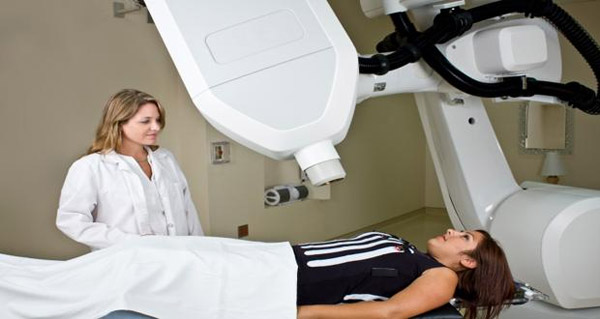
Brachytherapy is a type of internal radiotherapy that involves putting a radioactive source close to, or in the tumour. It is often performed after a CT or MRI scan has pinpointed the exact position of the cancer, so that the radiation treatment can be targeted precisely; this is called image-guided brachytherapy (IGBT). During intracavitary (IC) brachytherapy, the radioactive applicator is placed in the uterus and the vagina, while interstitial (IS) brachytherapy involves inserting needles directly into the tumour to deliver the radiation.
In a presentation to the 3rd ESTRO Forum in Barcelona, Spain, on Saturday, Dr Lars Fokdal (MD, PhD), a consultant at the Aarhus University Hospital, Denmark, will say: “Image-guided brachytherapy has transformed treatment for cervical cancer considerably, and dose adaptation and a combination of intracavitary and interstitial brachytherapy enable us to deliver radiation that is targeted at the tumour while avoiding other organs. However, although some centres are using IC/IS brachytherapy, there are concerns that the technique might increase the likelihood of adverse side-effects occurring three months or more after the end of radiation treatment.”
Dr Fokdal and colleagues in Austria, France, UK, Slovenia, The Netherlands and Ireland, enrolled 731 women with cervical cancer that had started to spread into nearby tissues (locally advanced) into the “retroEMBRACE” study — a study that collected retrospective data on the use of IGBT to treat cervical cancer in nearly 800 women in 12 different countries. The researchers analysed data from a group of 300 patients from institutions that systematically used combined IC and IS brachytherapy on more than 20% of women, and a group of 310 patients from institutions where the most common treatment used was IC brachytherapy alone.
“We found that combined IC/IS brachytherapy enabled us to deliver higher doses to the tumour without delivering more radiation to the bladder and the bowel. This meant that there was no increased risk in severe adverse side-effects three or more months later, but there is a better chance of a cure,” he will tell the conference.
“These results show that combined IC/IS brachytherapy is a good treatment and should serve as a benchmark for future brachytherapy in cervical cancer.”
Problems (morbidity) caused by radiotherapy for cervical cancer can include bladder and bowel dysfunction; in rare cases they can include the narrowing, loss of flexibility or drying of the vagina or bowel (known as stenosis) or holes forming in the wall of the vagina, bowel or bladder (fistulas). These are graded from 0 for no problems to 5 for death related to radiation treatment.
After a median follow-up of 40 months, ranging from three to 163 months, the researchers found there was no significant difference in late bladder, gastro-intestinal or vaginal grade 2-5 morbidities between the two groups of patients.
Among the patients in the group more likely to receive IC/IS brachytherapy, 66% (versus 52% in the other group) received high-dose rate brachytherapy, and 47% versus 4% received the combined IC/IS treatment. In addition, 97% (versus 66%) of patients in the IC/IS group benefited from their radiation doses being planned with the aid of MRI scans. Compared to the group least likely to receive IC/IS brachytherapy, the radiation dose in the IC/IS group of patients reached more of the targeted tumour area, with at least 90% of the tumours receiving a dose that was 9Gy higher than in the non-IC-IS patients. However, these higher, targeted doses in the IC/IS group of patients did not result in higher doses of radiation to the bowel, and radiation doses to the bladder was an average of 4Gy lower.
Professor Philip Poortmans, President of ESTRO, commented: “Dr Fokdal and colleagues show again that intensive close collaboration between high-level departments from several countries can help to extend our knowledge of how to further improve the outcome of our patients. This specific study of the EMBRACE network shows how the best results may be obtained by properly using the newest technical developments in the field of brachytherapy. Now, the next step is to teach these optimised techniques to all our other colleagues who treat locally advanced cervical cancer but do not yet use interstitial techniques as an addition to intracavitary ones.” The study done by European Society for Radiotherapy and Oncology (ESTRO).